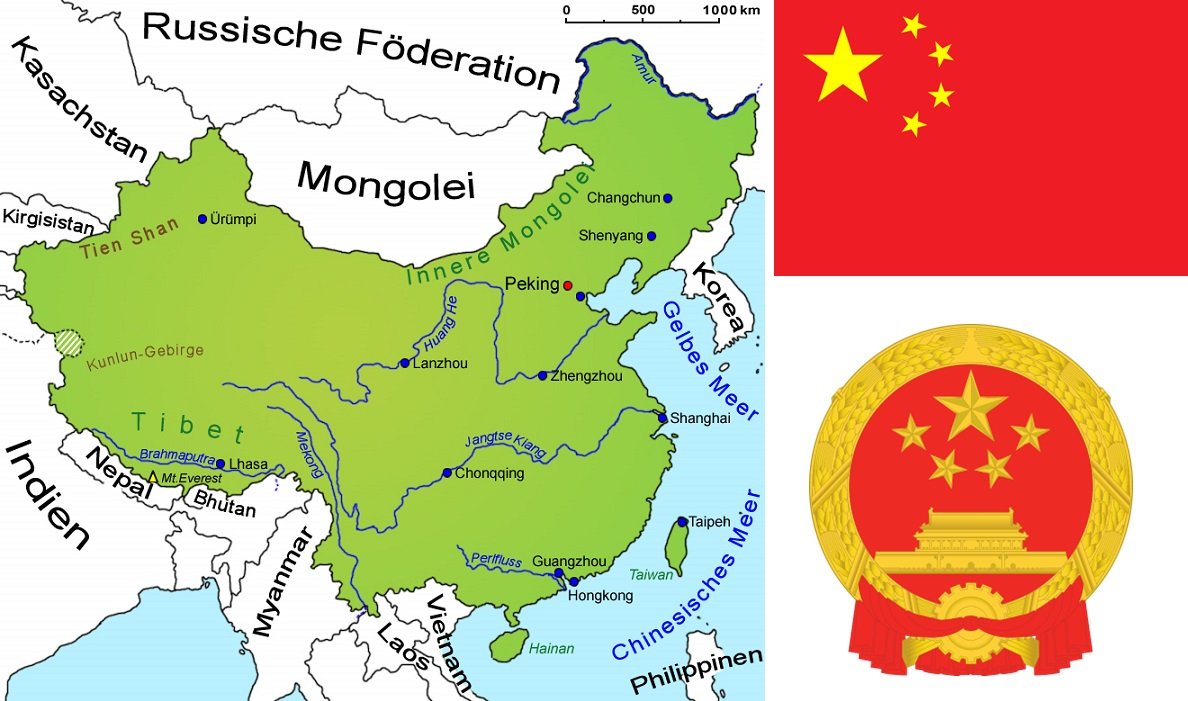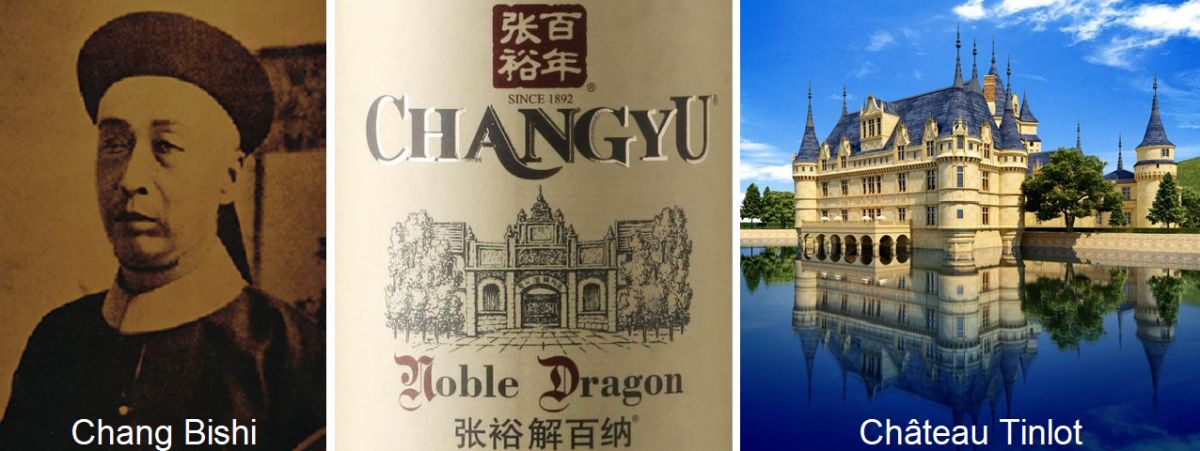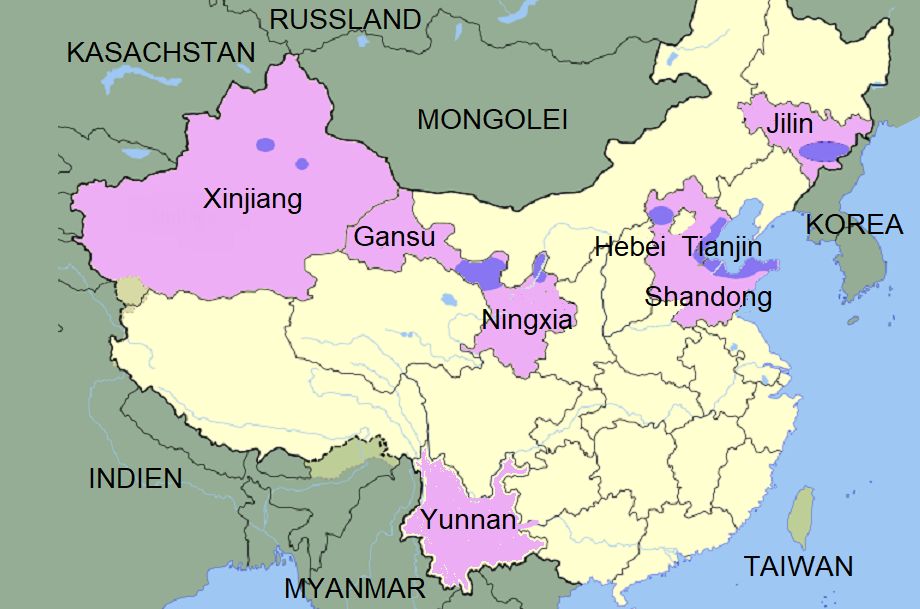The People's Republic of China (Chinese 中华人民共和国, pinyin Zhōnghuá Rénmín Gònghéguó) in East Asia with its capital Beijing covers 9,596,961 km² and is the third largest country in the world. It borders 14 neighbouring countries: Vietnam, Laos, Myanmar, Bhutan and Nepal to the south, India, Pakistan and Afghanistan to the west, Tajikistan, Kyrgyzstan, Kazakhstan, Russia and Mongolia to the north and North Korea to the east. To the east and south-east, it lies on the Yellow, East China and South China Seas. The territory stretches from the northernmost tip on the Siberian border to the southern tip of Hainan Island over around 5,500 kilometres and from east to west over around 5,200 kilometres.

History
The contents of 200 clay pots found near Rizhao (Shandong) in 1995, which were dated to 2,600 BC, indicate that grapes were grown in China as long as 4,600 years ago. Residues of grape wine were found in them. The explorer Zhang Qian (195-114 BC) returned from his travels in the west in 138 BC during the Han Dynasty and brought with him knowledge of viticulture. The first written documents date back to the Tang Dynasty (618-907), when Emperor Li Shimin vulgo Taizong (599-649) noticed the special quality of the grapes from the Turpan Basin, which is why he had his territory extended to the north-western region of Xinjiang. Vinifera varieties called Snake, Mare's Nipple and Dragon's Pearl were probably introduced from Russia as early as the middle of the 7th century. Marco Polo (1254-1324) reports on vineyards and excellent wine in the north-eastern region of Taiyuan. In the 14th century, however, many vineyards were cleared by imperial order in favour of grain cultivation.
Wine never became an important part of life in China as it did for all other great civilised peoples. In addition to the climate, which in large areas is characterised by cold winters and extremely hot summers, this is also due to the eating habits, as in Chinese cuisine, at least in some areas, particularly spicy dishes are popular, with which rice brandy goes much better than wine. However, reducing food to spicy does not do China justice. There are large areas that do not have spicy cuisine. In particular, these are Guangdong, Shandong, Xinjiang, Shanghai, Beijing and north-east China. Grape wine (grape alcohol), as it is known in China, also played a subordinate role alongside rice wine (mijiu) for a very long time when it came to low-alcohol beverages. For over a thousand years, wine remained an exclusive rarity for a wealthy minority; this is only now beginning to change rapidly.
Beginning of the modern history of viticulture
Modern Chinese wine history began in 1892, when the businessman Cheong Fatt Tze, known as Chang Bishi (1840-1916), bought land in Yantai (Shandong), introduced 150 varieties with around 500,000 vines from Europe and the USA and founded the Chang Yu winery. The Austro-Hungarian consul Baron Max von Babo (1862-1933) was engaged as advisor and cellar master. He imported barrels, presses and 400,000 Welschriesling seedlings from Austria and brought the winery to international renown. This was the birth of the wine multinational Yantai Changyu Pioneer Wine Company. At the beginning of the 20th century, other large wineries were founded, such as Shang-Yi (now Beijing Friendship Winery) in Shandong by French missionaries in 1910, Melco in Quingdao by German missionaries in 1914 and Tung-Hua in Jilin by Japanese missionaries. At the same time, French monks in Yunnan were practising viticulture locally but with an astonishing influence on the population, which continues to this day.

After the founding of the People's Republic of China in 1949, extensive vineyards were planted along the Yellow River. From the end of the 1970s, foreign investments were encouraged. From 1980, the French company Rémy Martin produced the Dynasty brand. The "Huadong Winery" in Qingdao (Shandong) was established in 1985 and acquired by Allied Domecq in 1990. The French company Pernod Ricard founded the "Dragon Seal" brand with the "Beijing Friendship Winery" in 1987. In 1978, Chateau Huaxia was founded with the "Greatwall" brand, which belongs to the largest state-owned food group COFCO. The "Marco Polo Winery" in Yantai was established in 1990, and the Spanish company Torres founded the wine wholesaler "Torres China" in 1997. The Hong Kong chemical company Leung's Group acquired the Suwu Zhuangyan Winery in Gansu in 2000. Other important wineries are Long Dai and Nine Peaks. These companies imported European varieties, modern winery facilities and employed foreign oenologists. The top 10 wineries in China produce around 80% of the wine volume.
Wine-growing regions
China is divided into 11 wine-growing regions, which differ greatly in terms of climate and soil type due to the enormous size of the country. In the east, starting north of Shanghai to the far north-west on the border with Mongolia, there are several large wine-growing areas on the coast of the Yellow and South China Seas. The most suitable wine-growing region for European varieties is the province or peninsula of Shandong, south of Beijing, with the best sub-areas of Lao Shan and Da Za Shan. It lies on the lower reaches of the Yellow River (Huang He) and has coasts facing the Gulf of Bohai and the Yellow Sea. Due to its proximity to the sea, it has a maritime climate. The hay rainy season is June/July during the ripening period, and large amounts of rain fall during the harvest. This is followed by the province of Hebei with the sub-region of Changli, known as the "Bordeaux of China", where the Tyrolean company Swarovski-Langes operates the "Bodega Langes". Other large wine-growing regions in north-east China are Tianjin, Liaoning and Jilin.

The most important and most promising wine-growing region is the north-central province of Ningxiawhich was declared an official pilot zone in 2021. Other areas are north-west Gansu and south-west Yunnan-Guizhou Plateau. The largest wine-growing area in Xinjiang is located in the far north-west. The earliest Chinese vineyards mentioned at the beginning existed here in the Turpan Basin as early as the 2nd century BC. The sunny region with calcareous sandy soils and large 24-hour temperature differences that promote the flavours is considered the best for viticulture. The " Tibet Autonomous Region" in the south-west of the country has been an administrative unit of the People's Republic of China on the territory of historic, formerly independent Tibet since 1965. Viticulture is also practised here on a small scale.
Vineyards, grape varieties and production volumes
In 2022, the vineyards covered 784,750 hectares and the wine production volume was 4.2 million hectolitres. The many autochthonous varieties are mostly descended from wild vines. Many vines are not grafted, as phylloxera has not yet been found here. Beichun, Longyan (Dragon's Eye), Jifeng, Mare's Teat, Bai Ji Xin (Chicken Heart) and crosses of Muscat d'Hamburg with varieties of the Asian species Vitis amurensis are mainly used for the table grapes and sultanas produced on a large scale. Around 80% of the vineyards are planted with non-vinifera varieties. The grape variety index includes the quality wine grape varieties with around 100,000 hectares for wines of European standard:
Grape variety |
Colour |
Synonyms |
Hectare |
| Cabernet Sauvignon | red | - | 40.300 |
| Merlot | red | - | 16.700 |
| Carmenère | red | Cabernet Gernischt | 11.200 |
| Chardonnay | white | - | 6.100 |
| Yan 73 | red | - | 4.800 |
| Garnacha Tinta | red | Grenache Noir | 4.000 |
| Welschriesling | white | Graševina | 3.000 |
| Muscat d'Alexandrie | white | - | 3.000 |
| Sauvignon Blanc | white | - | 2.000 |
| Beibinghong | red | - | 1.600 |
| Riesling | white | - | 1.600 |
| Trebbiano Toscano | white | - | 1.500 |
| Vidal Blanc | white | - | 1.500 |
| Longyan | red | - | 1.000 |
| Syrah | red | Petite Sirah, Shiraz | 1.000 |
| Cabernet Franc | red | - | 600 |
| Pinot Noir | red | - | 400 |
| Mazuelo | red | Carignan Noir | 100 |
| Chenin Blanc | white | - | ? |
| Cinsaut | white | Cinsault | ? |
| Crystal | white | - | ? |
| Gewürztraminer / Traminer | white | - | ? |
| Pinot Blanc | white | - | ? |
| Pinot Gris | white | - | ? |
| Sémillon | white | - | ? |
| Tuo Xian | white | Tuo Xian Putao | ? |
Wine law
There is no wine law according to European standards. According to the food law, imported wine bottled in China is considered a Chinese product. It is therefore common to blend Chinese wine with foreign wine. However, there is an origin law that allows wines to be certified according to their origin, such as Ningxia, Shandong and Xinjiang. The state is also increasingly intervening in unfair practices. In 2010, 30 wineries in the Hebei region were shut down after gush scandals and labelling fraud came to light. In 2013, General Secretary Xi Jinping (*1953) became the new president. He stepped up the fight against corruption.
Wine culture
Wine still plays a rather subordinate role in the daily lives of the Chinese. One of the main reasons for this is its relatively high price. Prices of 50 euros and more per bottle, especially for products from abroad, are not uncommon and are therefore unaffordable for many. However, per capita consumption per year is constantly on the rise and is already around one bottle compared to a quarter of a litre at the end of the 1990s.
The most popular light alcoholic drink is beer, while the national drinks are baijiu (spirits) and mijiu (rice wine). There is a trend towards red wine in particular, mainly due to the great importance of the colour red and the widespread belief in the positive aspects of alcohol consumption. After all, red is not only the national colour, but also a symbol of wealth, power and happiness in Chinese culture. This is also manifested in the name for wine, which is usually referred to as pútáojiǔ (grape alcohol), but also as hóngjiǔ (red alcohol) regardless of the colour.
More than 90% of production is consumed domestically. However, wine is only drunk by the upper middle classes and is considered a drink of the wealthy. In China, only around 40 million of the 1.4 billion people drink wine (3%). Chinese consumers are still learning, so to speak; wine is often mixed with Coca Cola and red wine is chilled with ice cubes. The centuries-old tradition of Gānbēi, as with schnapps (ex-drinking), is also still widespread. Wine production amounts to around 16 million hectolitres, making China the fifth largest wine producer in the world. The state is investing heavily in wineries and structures in order to position China among the top 3 wine producing countries.
Text contribution: Jörg Philipp, PAR Ambassador Asia, www.degustar.de
Map: © Goruma
Flag: by SKopp, Public domain, Link
Coat of arms: by 澳门特别行政区立法会, Public domain, Link
Picture Yantai Changyu: Changyu - Since 1892
Map of wine-growing areas: By Pancrat - Own work, CC BY-SA 3.0, Link
Voices of our members

There is a vast number of sources on the web where one can acquire knowledge about wine. But none has the scope, timeliness and accuracy of the information in the encyclopaedia at wein.plus. I use it regularly and rely on it.
Sigi Hiss
freier Autor und Weinberater (Fine, Vinum u.a.), Bad Krozingen